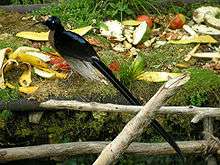Brown sicklebill
| Brown sicklebill | |
|---|---|
 | |
| Scientific classification | |
| Kingdom: | Animalia |
| Phylum: | Chordata |
| Class: | Aves |
| Order: | Passeriformes |
| Family: | Paradisaeidae |
| Genus: | Epimachus |
| Species: | E. meyeri |
| Binomial name | |
| Epimachus meyeri Finsch & Meyer, 1885 | |
The brown sicklebill (Epimachus meyeri) is a species of bird-of-paradise.
It is distributed to mountain forests of New Guinea, Its appearance resembles the closely related and larger black sicklebill. In areas where these two large sicklebills met, the brown sicklebill replaced the latter species in higher altitudes. Its diet consists mainly of fruits, arthropods and small animals.
This bird was discovered by Carl Hunstein in 1884 and named after Adolf Bernard Meyer of Dresden Museum, Germany.
The brown sicklebill is evaluated as Least Concern on the IUCN Red List of Threatened Species. It is listed on Appendix II of CITES.
Description


The brown sicklebill is large, up to 96 cm long, dark blue and green with highly iridescent plumages, a sickle-shaped bill, pale blue iris and brown underparts. The male is adorned with ornamental plumes on the sides of its rear and a huge sabre-shaped central tail feathers that are highly prized by natives. The female is a reddish-brown bird with buff barred black below.
Subspecies
- Epimachus meyeri albicans
- Epimachus meyeri bloodi
- Epimachus meyeri megarhynchus
- Epimachus meyeri meyeri
References
- ↑ BirdLife International (2012). "Epimachus meyeri". IUCN Red List of Threatened Species. Version 2013.2. International Union for Conservation of Nature. Retrieved 26 November 2013.
External links
| Wikimedia Commons has media related to Epimachus meyeri. |
| Wikispecies has information related to: Epimachus meyeri |
